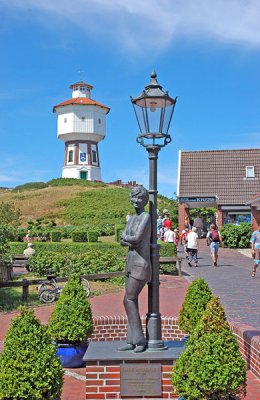LILI MARLENE:
STORY OF A UNIVERSAL SONG
Surely the favourite song of soldiers during World War II, Lili Marleen became the unofficial anthem of the foot soldiers of both forces in the war.
Original German lyrics from a poem “The Song of a Young Sentry” by World War I German soldier, Hans Leip *22.9.1893 in Hamburg, †6.6.1983 in Fruthwilen, near Frauenfeld (Thurgau), Switzerland who wrote these verses before going to the Russian front in 1915, combining the name of his girlfriend, Lili (the daughter of a grocer), with that of a friend's girlfriend or by a wave given to Leip, while he was on sentry duty, by a young nurse named "Marleen" as she disappeared into the evening fog. But according to German Wikipedia, a second (and very curious) origin of the name could be possible: Hans Leip was supposed to be in love with Lilly Freud (1888-1970), Sigmund Freud's niece (she was his sister Marie's daughter). Hans Leip himself said later she was his girlfriend; but the girl, who was an actress, left him and married (1917) the actor and director Arnold Marlé. So, Leip wrote the song with the original title of “Lilly Marlé”, that was later to become “Lili Marleen”. Lilly Freud-Marlé herself declared it was common saying in her family that she really was the Lili Marleen of the song. If this story would be true, it would be really hironical: the Wehrmacht soldiers used to sing a song written for a Jew girl.
Hans Leip's poem was later published in a collection of his poetry in 1937. The poems caught the attention of Norbert Schultze (born 1911 in Braunschweig, died 17.10.2002), who set this poem to music in 1938 and gave it the title Das Mädchen unter der Laterne (The Girl under the Lantern). Schulze was already rich and famous before the success of The Girl under the Lantern, who awaited her lover by the barrack gate. His operas, film scores, marches and tunes for politically inspired lyrics were successful. In 1945 the Allies told Schultze to forget about composing but he got back to it in 1948.
The tune had a rocky road. The propaganda secretary of the Nationalist-Socialist party, Joseph Goebbels didn't like the song, he wanted a march. Lale Andersen didn't want to sing it and the DJ who was supposed to get it on the charts also gave it two thumbs down.
Recorded just before the war by Lale Andersen (Eulalia Bunnenberg), the song sold just 700 copies, until German Forces Radio began broadcasting it to the Afrika Korps in 1941.
The songs was immediately banned in Germany, for its portentous character, which did nothing to slow its spread in popularity.
After the German occupation of Yugoslavia, a radio station was established in Belgrade and beamed news, and all the propaganda fit to air, to the Africa Corps. Lieutenant Karl-Heinz Reintgen, the director of Radio Belgrade had a friend in the Africa Corps who had liked the tune. He aired Lale Anderson's version for the first time on 18. August 1941. General Feldmarschall Rommel liked the song and asked Radio Belgrade to incorporate the song into their broadcasts, which they did. The song soon became the signature of the broadcast and was played at 9:55 pm, just before sign-off.
After the song was broadcast there was no holding it back. The Allies listened to it and Lili Marleen became the favourite tune of soldiers on both sides, regardless of language.
The immense popularity of the German version spawned a hurried English version, supposedly when a British song publisher named J.J. Phillips reprimanded a group of British soldiers for singing the verses - in German. One irate soldier shouted back : "why don't you write us some English words?". Phillips and a British songwriter Tommie Connor soon had an English version in 1944. Anne Sheldon's English hit record started the songs popularity with the Allied countries. Vera Lynn sang it over the BBC to the Allied troops. The British Eighth Army adopted the song.
It was sung in military hospitals and blasted over huge speakers, along with propaganda nuggets, across the frontlines, in both directions.
Marlene Dietrich featured The Girl under the Lantern in public appearances, on radio and "three long years in North-Africa, Sicily, Italy, in Alaska, Greenland, Iceland, in England," as she later recalled.
An RCA US recording, by an anonymous chorus in June, made it to No. 13 in 1944. It hit the US charts again in 1968, the German charts again in 1981 and the Japanese charts in 1986.
The song is said to have been translated into more than 48 languages, including French, Russian and Italian and Hebrew. Tito in Yuogoslavia greatly enjoyed the song.
Lili Marlene is easily the most popular war song ever. Its theme of dreaming for one's lover is universal. Why is the song so popular? The last word goes to Lale Anderson : "Can the wind explain why it became a storm?"
Burimi: Antiwar Songs (AWS)

Il monumento a Lili Marleen sull'isola tedesca di Langeoog. La "ragazza sotto il fanale" ha il volto di Lale Andersen.
